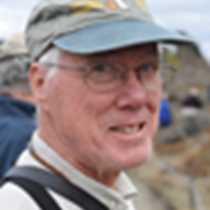Glacier Bay National Park
Tucked up in the northern corner of the panhandle of Southeast Alaska is Glacier Bay National Park. Together with two large parks in adjacent Canada, it forms the largest area of protected wilderness outside of Antarctica. When George Vancouver sailed through ice-choked Icy Strait in 1794 to chart the coastline of the Inside Passage, he found a small inlet that ended in a massive wall of glacial ice. Over the next century and a quarter, the ice retreated to reveal what we now know as Glacier Bay. It was the most rapid glacial retreat ever recorded. The oral history of the Tlingit people who now live in the village of Hoonah on Chichagof Island tells another story, of how an earlier advance of the glaciers (we call it the Little Ice Age) drove the people from their ancestral homeland in Glacier Bay. Now, as a national park, Glacier Bay belongs to all of the people of America, but it has special significance to the Hoonah Tlingit.
Today we followed the path of the retreating glaciers from park headquarters at Bartlett Cove to the end of the bay at the Margerie and Grand Pacific glaciers, 65 miles "up bay." In an early-morning stop at Bartlett Cove, we picked up a National Park Service Ranger, Linda, and a Tlingit Cultural interpreter, Bertha, who introduced herself in the traditional Tlingit way by telling her moiety (all Tlingit are either raven or eagle), her clan, and her house. In this, she was relating her ancestry to a particular region of Glacier Bay. We paused at the Marble Islands to see the richness of nesting birds and lounging Steller's sea lions. Within the memory of Hoonah elders, the Tlingit people harvested the eggs of glaucous-winged gulls at the Marble Islands as part of their subsistence way of life.
On Gloomy Knob, a massif of dolomite limestone, we gazed up at mountain goats clinging to impossibly steep slopes. A nanny stood up to nurse her young kid, only a few weeks old but already scampering along the narrow ledges. Goat meat nourished the Tlingit. The rich fur was woven into Chilkat blankets that were (and still are) a symbol of status in the Tlingit community. Goat hooves adorned their dance regalia, and the horns were carved and shaped into implements and spear points. Nothing was wasted.
In 1879, John Muir camped on Russell Island, at the edge of the retreating glacier. Today, a brown bear was feeding on sedges in a small coastal meadow near Muir's campsite. Later we watched another brown bear seeking a meal in the intertidal zone, turning over boulders with its enormously strong front legs. Salad and seafood. Brown bears are nearly gone from the lower states, but the rich productivity and undisturbed wilderness of Southeast Alaska supports an abundant population.
We reached the end of Glacier Bay at the Margerie and Grand Pacific glaciers, the former mostly blue/white with sharp pinnacles of ice, the latter covered with rock rubble carried down from the mountains above. The glaciers are here because the tall mountains of the Coast Range intercept moist winds from the Pacific Ocean and turn the moisture into snow. Lots of snow; as much as 40 feet in a single winter. Mount Fairweather, reaching 15,300 feet, is only fifteen miles from the outer coast. Today, as the sky continued to clear, the mountains of the Fairweather Range emerged from the clouds, providing stunning vistas as we made our way back toward Bartlett Cove and the end of our day in Glacier Bay.




